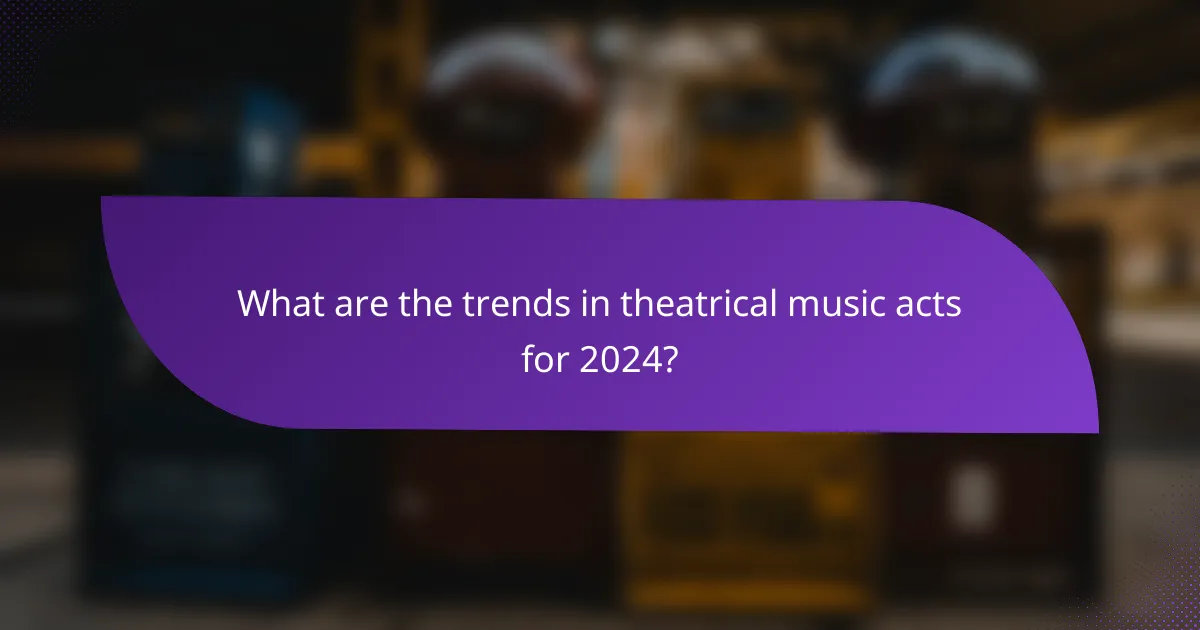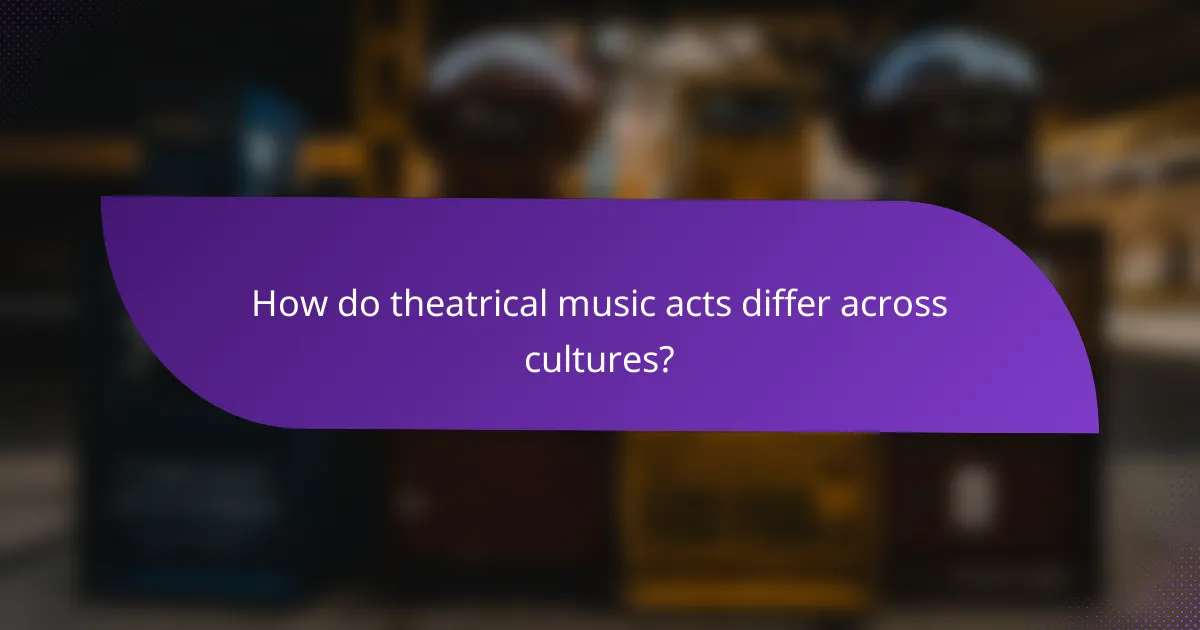Theatrical music acts are a captivating blend of storytelling, performance, and music that transport audiences into rich, imaginative worlds. With elaborate costumes and compelling narratives, these productions engage viewers on an emotional level, making each performance a memorable experience. From the grandeur of Broadway to the innovation of Off-Broadway, the art of theater continues to evolve while celebrating its dramatic roots.

What are the best theatrical music acts in New York City?
New York City is renowned for its vibrant theatrical music acts, featuring a mix of Broadway musicals, Off-Broadway performances, and experimental theater companies. Each offers unique storytelling, elaborate costumes, and compelling narratives that captivate audiences.
Broadway musicals
Broadway musicals are the pinnacle of theatrical music acts in New York City, showcasing large-scale productions with high budgets and star-studded casts. These performances often feature well-known songs and elaborate staging, drawing in millions of visitors each year.
Popular shows like “Hamilton,” “The Lion King,” and “Wicked” exemplify the genre’s blend of music, dance, and drama. Tickets can range from moderate to premium prices, often requiring advance booking due to high demand.
Off-Broadway performances
Off-Broadway performances provide a more intimate theater experience, typically in smaller venues with fewer than 500 seats. These shows often explore innovative narratives and experimental styles, allowing for greater artistic freedom compared to Broadway.
While ticket prices are generally lower than Broadway, they can still vary significantly based on the production. Notable Off-Broadway shows, such as “Blue Man Group” and “Stomp,” have gained popularity and critical acclaim, making them worthwhile options for theatergoers.
Experimental theater companies
Experimental theater companies in New York City push the boundaries of traditional theater, often incorporating multimedia elements, unconventional storytelling, and interactive experiences. These companies, such as The Wooster Group and Elevator Repair Service, challenge audiences to engage with the performance in new ways.
Tickets for experimental theater can be quite affordable, making it accessible for those looking to explore innovative art forms. Attending these performances can offer a fresh perspective on storytelling and music within the theatrical realm.

How do theatrical music acts create compelling narratives?
Theatrical music acts create compelling narratives by intertwining music, performance, and storytelling to engage audiences emotionally. These acts utilize character development, story arcs, and emotional engagement to craft memorable experiences that resonate with viewers.
Character development
Character development is crucial in theatrical music acts, as it allows audiences to connect with the performers on a personal level. Each character typically has a distinct personality, background, and motivation that unfolds throughout the performance, making them relatable and engaging.
For example, a protagonist may start as a timid individual who gradually gains confidence, showcasing their journey through song and dialogue. This evolution not only enhances the narrative but also encourages the audience to invest emotionally in the character’s fate.
Story arcs
Story arcs provide structure to theatrical music acts, guiding the audience through a beginning, middle, and end. A well-crafted story arc often includes conflict, climax, and resolution, which keeps viewers engaged and eager to see how the narrative unfolds.
In many cases, the story arc is complemented by musical numbers that highlight key moments, such as a dramatic confrontation or a heartfelt revelation. This integration of music and narrative ensures that the audience remains captivated throughout the performance.
Emotional engagement
Emotional engagement is a vital aspect of theatrical music acts, as it fosters a deeper connection between the audience and the performance. Through powerful lyrics, evocative melodies, and expressive acting, performers can evoke a wide range of emotions, from joy to sorrow.
To enhance emotional engagement, creators often use techniques such as dynamic staging, lighting changes, and audience interaction. These elements help to create an immersive experience, allowing viewers to feel as though they are part of the story rather than mere spectators.

What are the key elements of elaborate costumes in theater?
Elaborate costumes in theater are essential for conveying character, setting, and mood. They combine historical accuracy, symbolic representation, and material choices to create a visually compelling narrative that enhances the overall performance.
Historical accuracy
Historical accuracy in costumes ensures that the attire reflects the correct time period and cultural context of the play. Designers often research fashion trends, fabrics, and accessories from the era to create authentic looks. For example, a production set in the Victorian era would feature corsets, petticoats, and period-appropriate fabrics like silk or wool.
When aiming for historical accuracy, consider the social status of characters as well. Wealthy individuals would wear more luxurious materials and intricate designs, while lower-class characters might have simpler, more practical clothing. This attention to detail helps immerse the audience in the story.
Symbolic representation
Costumes often serve as symbols that convey deeper meanings about characters and themes. Colors, styles, and accessories can represent traits such as innocence, power, or conflict. For instance, a character dressed in dark colors may symbolize evil or mystery, while bright colors can indicate joy or purity.
Additionally, specific items like masks or capes can enhance a character’s persona or signify transformation. Designers should consider how each costume element contributes to the narrative and the audience’s understanding of the characters’ journeys.
Material choices
Material choices play a crucial role in the overall impact of theatrical costumes. The selection of fabrics can affect not only the visual appeal but also the comfort and mobility of the actors. Common materials include cotton, polyester, and silk, each offering different textures and appearances.
When choosing materials, consider the practical aspects such as durability and ease of maintenance. For instance, costumes for outdoor performances may require weather-resistant fabrics, while intricate designs might benefit from lighter materials that allow for ease of movement. Balancing aesthetics with functionality is key to effective costume design.

How do theatrical music acts enhance audience engagement?
Theatrical music acts enhance audience engagement by combining storytelling, music, and visual elements to create a captivating experience. These performances draw viewers in, making them active participants in the narrative rather than passive observers.
Interactive performances
Interactive performances invite the audience to become part of the show, breaking the fourth wall and fostering a deeper connection. This can include actors asking questions or encouraging audience members to respond, which can lead to spontaneous and memorable moments.
For example, some musicals may allow audience members to choose between different story paths, creating a unique experience each time. This level of involvement can significantly increase emotional investment in the performance.
Audience participation
Audience participation is a key element in many theatrical music acts, where viewers are encouraged to sing along, dance, or even join the performers on stage. This engagement transforms the atmosphere, making it more lively and communal.
Events like sing-along screenings of popular musicals or immersive theater experiences often rely on audience participation to create a shared sense of joy and excitement. The more the audience engages, the more memorable the experience becomes.
Immersive experiences
Immersive experiences in theatrical music acts transport the audience into the world of the performance, often through elaborate sets, costumes, and sound design. This total immersion can evoke strong emotional responses and create lasting impressions.
Productions that utilize 360-degree staging or site-specific performances allow the audience to explore the environment, enhancing their connection to the story. The use of technology, such as augmented reality, can further deepen this immersive experience, making the audience feel as though they are part of the narrative.

What are the trends in theatrical music acts for 2024?
In 2024, theatrical music acts are increasingly embracing technology, diversity, and environmental themes. These trends reflect a shift towards more immersive experiences, inclusive narratives, and a commitment to sustainability in the performing arts.
Incorporation of technology
The integration of technology in theatrical music acts is transforming performances into multi-sensory experiences. From advanced lighting and sound systems to virtual reality elements, productions are using tech to enhance storytelling and audience engagement.
For example, some shows are incorporating augmented reality to allow audiences to interact with characters or settings in real-time. This trend not only captivates viewers but also creates unique experiences that can vary from performance to performance.
Focus on diversity
Diversity in theatrical music acts is becoming a priority, with a growing emphasis on representation across race, gender, and culture. Productions are increasingly featuring stories from underrepresented communities, allowing for a richer tapestry of narratives.
In 2024, expect to see more diverse casting choices and inclusive storytelling that resonates with a broader audience. This shift not only enriches the artistic landscape but also fosters a sense of belonging among viewers from various backgrounds.
Environmental themes
Environmental themes are gaining traction in theatrical music acts, reflecting global concerns about climate change and sustainability. Productions are weaving ecological messages into their narratives, prompting audiences to consider their impact on the planet.
For instance, some shows are utilizing sustainable materials for costumes and sets, while others incorporate eco-friendly practices in their production processes. This trend encourages both artists and audiences to engage in meaningful conversations about environmental responsibility.

How do theatrical music acts differ across cultures?
Theatrical music acts vary significantly across cultures, shaped by local traditions, storytelling methods, and musical styles. These differences reflect the unique narratives and artistic expressions that resonate within each community.
Regional storytelling styles
Storytelling in theatrical music acts often aligns with cultural values and historical contexts. For instance, in Western cultures, narratives may focus on individualism and personal journeys, while many Asian traditions emphasize collective experiences and moral lessons. This divergence influences how stories are presented, from the use of monologues to ensemble performances.
In Africa, storytelling is frequently interwoven with dance and music, creating a holistic experience that engages the audience in a communal narrative. Similarly, Indigenous cultures in the Americas often use oral traditions to convey history and spirituality, integrating music as a vital storytelling tool.
Musical influences
The musical elements of theatrical acts are deeply rooted in regional sounds and instruments. For example, European theatrical music often incorporates classical elements, while Latin American acts might blend folk rhythms with contemporary styles, resulting in vibrant performances. These influences shape the overall atmosphere and emotional impact of the acts.
In Asia, traditional instruments like the sitar in Indian performances or the erhu in Chinese theater play crucial roles, adding unique textures to the music. Understanding these musical influences can enhance appreciation for the cultural significance behind each theatrical presentation.
